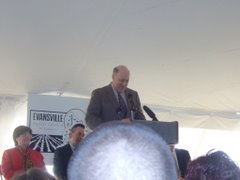Memorandum
To: Redevelopment Authority Commissioners
Cc: James Otterstein, Rock County Economic Development Coordinator
From: Bill Connors, City Administrator
882-2263
Date: Dec. 20, 2005
Re: Cash Flow Projection for TID No. 5
I have attached a cash flow speadsheet that is identical to the spreadsheet that is Exhibit 3 on page 14 of the amended project plan for TID No. 5, which was prepared by David Wagner of Ehlers & Associates. James Otterstein suggested that I provide you with some explanation of this document for background information when you are making recommendations on investments using tax increment from TID No. 5.
The second column from the left, labeled “Projected Tax Increment,” projects tax increment to be collected. It assumes construction will add the following amounts of value in TID No. 5 in the following years (taken from Exhibit 1 on page 11 in the amended project plan):
$622,300
$1,250,000
$2,507,500
$2,515,000
$775,000
$800,000
$800,000
$800,000
$800,000
$800,000
$300,000
Total $11,969,800
The third column from the left shows a series of debt issues based on the assumptions in the “Key Assumptions” box above the spreadsheet. For example, it was assumed that public improvements would total $3,490,900. The recent decision by the Finance and Labor Relations Committee not to recommend amending the 2005 adopted capital budget to designate $450,000 of Exchange St. costs as being financed by TID No. 5 has reduced the estimated total public improvement expenditures to $3,040,900.
The fifth column from the right, labeled “Net TID 5 Payments,” shows the projected uses of tax increment each year to pay debt service and other costs. The fourth column from the right, labeled “Annual Balance,” shows the difference each year between the amount in column labeled “Projected Tax Increment” and the amount in the column labeled “Net TID 5 Payments.” The third column from the right, labeled “Cum. Balance,” shows a cumulative total of the amounts in the column labeled “Annual Balance.”
The amount in the “Cum. Balance” column never goes negative. David Wagner was able to achieve this result by using debt service schedules that call for most of the principal to be repaid in later years, which is quite typical of TIF-related municipal debt service issues.
However, the intention of this spreadsheet was to show, in general terms, that TID No. 5 could generate enough tax increment flow to finance all of the costs included in the amended project plan budget, not to show precisely, year by year, how the cash flow would work. For example, the first borrowing related to TID No. 5 occurred in 2005, not 2006, so debt service costs have been incurred earlier than shown in this spreadsheet. Second, the administrative expenses not associated with debt issues have not been capitalized, which increases the use of cash in the short term but decreases the use of cash in the long term. If this spreadsheet were to be modified to show the actual sources and uses of cash for TID No. 5 during the opening years of the district, it probably would show some negative numbers in the “Cum. Balance” column.
There are “threats” to the viability of this cash flow projection. First, developers might not come forward with projects that would increase the value of improvements by a total of almost $12 million, or developers might not bring these projects forward soon enough, or they might insist on public contributions having a present value in excess of the $1.5 million budgeted. As you can see by comparing $12 million in increased value from projects with $1.5 million in incentives to developers, we need developers to bring forward large projects that do not consume all of the tax increment they generate.
Second, the total property tax rate on equalized value in the city has been decreasing. Exhibit 1 in the original project plan for TID No. 5 used a rate of .02800 for calculating projected tax increment, while Exhibit 1 in the amended project plan used a rate of .02673. David Wagner said if he updated this spreadsheet again, he would use a rate of .02423, the actual rate for 2005/2006 property taxes. As the total property tax rate on equalized value decreases, the amount of tax increment on the same value decreases.
Thursday, January 19, 2006
TIF #5 Update: Dialogue for Redevelopment meeting Tonight challenges all to find WIN-WIN projects; Win for investors, Win for taxpayers; Stay tuned
Subscribe to:
Post Comments (Atom)






























No comments:
Post a Comment